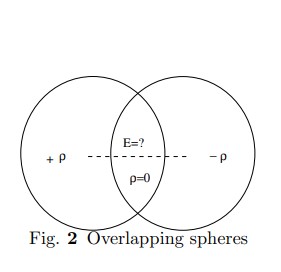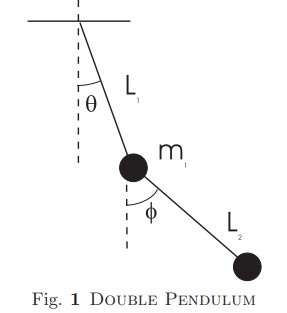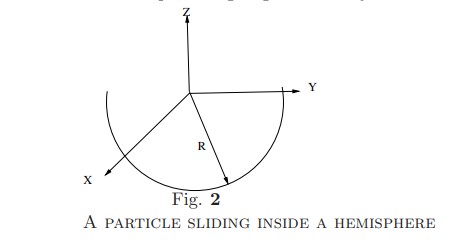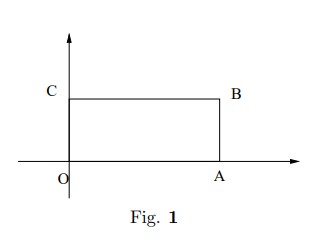|
|
[QUE/CM-10010]Node id: 2896pageThe dynamics of interacting particles is governed by a Hamiltonian
\[H = \sum_{i=1}^N\frac{|p_i|^2}{2m_i} + \frac{1}{2}
\sum_{i=1}^N\sum_{j=1}^N V_{ij}(\vec{r}_i-\vec{r}_j).\]
Suppose that we are viewing this system from a uniformly accelerating frame
\[\vec{r}^\prime_i = \vec{r}_i -\frac{1}{2} t^2.\]
Show that one can choose the canonical transformation connecting the to frames that is type 2 generating function \(F_2(\vec{r},\vec{p}^\prime,t)\) so that the Hamiltonian \(H^\prime\) in the accelerating frame has the same form as \(H\), except for an additional term which can be interpreted as arising out from the presence of an effective gravitational field \(-\vec{a}\). What is then the relation between the momenta \(\vec{p}_i\) and \(\vec{p}_i^\prime\) in the to frames?
Source:Calkin
|

|
22-04-06 14:04:34 |
n |
|
|
[2019EM/HMW-03]Node id: 5365pageElectrodynamics March 8, 2019 Tutorial-III
- The potential takes the constant value \(\phi_0\) on the closed surface \(S\) which bounds the volume \(V\). The total charge inside V is \(Q\). There is no charge anywhere else. Show that the electrostatic energy contained in the space outside of S is \(\displaystyle U_\text{E}(out)=\frac{1}{2} Q\phi_0\)
- The line segment between \(A\) to \(B\) in the diagram below carries a uniform charge per unit length \(\lambda\). The vector \(\vec{a}\) is coincident with the segment. The vectors \(\vec{b}\) and \(\vec{c}\) point from the observation point \(\vec{r}\) to the beginning and end of \(\vec{a}\), respectively.
 Evaluate the integral for the potential in a coordinate-free manner by parameterizing the line source using a variable \(s\) which is zero at the point on the charged segment that is closest to \(\vec{r}\). Show thereby that \begin{eqnarray} \phi(\vec{r}) &=& \frac{\lambda}{4\pi\epsilon_0}\ln {\left|\frac{\vec{b}\cdot\vec{a}}{a} +\sqrt{\left(\frac{\vec{b}\cdot\vec{a}}{a}\right)^2 + \frac{|\vec{b}\times\vec{a}|^2}{a^2} } \right| }\nonumber\\ && -\frac{\lambda}{4\pi\epsilon_0} \ln {\left|\frac{\vec{c}\cdot\vec{a}}{a} +\sqrt{\left(\frac{\vec{c}\cdot\vec{a}}{a}\right)^2 + \frac{|\vec{b}\times\vec{a}|^2}{a^2} } \right| } \end{eqnarray} Evaluate the integral for the potential in a coordinate-free manner by parameterizing the line source using a variable \(s\) which is zero at the point on the charged segment that is closest to \(\vec{r}\). Show thereby that \begin{eqnarray} \phi(\vec{r}) &=& \frac{\lambda}{4\pi\epsilon_0}\ln {\left|\frac{\vec{b}\cdot\vec{a}}{a} +\sqrt{\left(\frac{\vec{b}\cdot\vec{a}}{a}\right)^2 + \frac{|\vec{b}\times\vec{a}|^2}{a^2} } \right| }\nonumber\\ && -\frac{\lambda}{4\pi\epsilon_0} \ln {\left|\frac{\vec{c}\cdot\vec{a}}{a} +\sqrt{\left(\frac{\vec{c}\cdot\vec{a}}{a}\right)^2 + \frac{|\vec{b}\times\vec{a}|^2}{a^2} } \right| } \end{eqnarray}
- Suppose the electrostatic potential of a point charge were \[V (r) =\frac{q}{4\pi\epsilon_0}\frac{1}{r^{(1+\epsilon)}}\] rather than the usual Coulomb formula.
- Find the potential \(V(r)\) at a point at a distance \(r\) from the center of a spherical shell of radius \(R > r\) with uniform surface charge per unit area \(\sigma\). Check the Coulomb limit \(\epsilon = 0\).
- To first order in \(\epsilon\), show that \begin{equation} \frac{V(R)-V(r)}{V(R)} =\frac{\epsilon}{2}\left[\frac{R}{r}\ln\frac{R+r}{R-r} - \ln \frac{4R^2}{R^2-r^2}\right] \end{equation}
Since the time of Cavendish, formulas like this one have been used in experimental tests of the correctness of Coulomb’s law.
- Find the primitive, Cartesian monopole, dipole, and quadrupole moments for each of the following charge distributions. Use the geometrical center of each as the origin.
- Two charges \(+q\) at two diagonal corners of a square \((\pm a, \pm a, 0)\) and two minus charges \(−q\) at the two other diagonals of the square \((\pm a, \mp a, 0)\).
- A line segment with uniform charge per unit length λ which occupies the interval \(-\ell \le z \le \ell\).` .
- An origin-centered ring in the \(X-Y\) plane with uniform charge per unit length \(\lambda\) and radius \(R\).
|

|
22-04-05 16:04:07 |
n |
|
|
[2019EM/HMW-02]Node id: 5364pageElectrodynamics Feb 21, 2019
Tut-02
- A line charge carrying a charge \(\lambda\) per unit length and extending from \(-a,0,0\) to \(+a,0,0\) lies along the \(x\)- axis. Find the potential at a point on the \(X\)- axis at point \((d,0,0), d>0\) and at a point \((0,d,0)\) on the \(Y\)-axis.
|

|
22-04-05 16:04:46 |
n |
|
|
[2019EM/QUIZ-10]Node id: 5362pageElectrodynamics Apr 8, 2019
Quiz-X
- At the upper surface of the Earth’s atmosphere, the time-averaged magnitude of the Poynting vector \(<S> =1.35^10^{W/m}^2\) is referred to as
the solar constant.
- Assuming that the Sun’s electromagnetic radiation is a plane sinusoidal wave, what are the magnitudes of the electric and magnetic fields?
- What is the total time-averaged power radiated by the Sun? The mean Sun-Earth distance is \(R =1.50\times10^{11}\) m .
- Following equation contains the complete information about the electromagnetic wave \begin{equation*} \vec{E}(z,t)=E_0\sin(kz-\omega t)\hat{i} \end{equation*} Find the directions of wave propagation, wavelength, frequency, speed of propagation, magnetic field, the Potynting vector and the intensity of the wave.
|

|
22-04-04 17:04:27 |
n |
|
|
[2019EM/QUIZ-09]Node id: 5361pageElectrodynamics Apr 19, 2019
Quiz-IX
The above image is reproduced from a book. Read Example 8.5 carefully. Answer the following questions.
- Do you agree that there is no flux linked with the circuit when key is open?
- Do you agree that there will be induced current when the circuit is closed. But the coil and the magnet remain stationary?
- If you disagree what is the mistake? Does the flux rule apply or not in this case?
- Write any other comment you may have.
|

|
22-04-04 17:04:58 |
n |
|
|
[2019EM/QUIZ-08]Node id: 5360pageElectrodynamics Apr 19, 2019
Quiz-VIII
Question 1:
A student was asked to find the electric field inside
a uniformly polarized sphere. The following answer was received.
Sample Answer:

The answer to the above question as given in Griffiths is
\(\vec{E}=-\frac{\vec{P}}{3\epsilon_0}\)
- Give your comments why is this answer wrong?
- Give a counter example showing that the conclusion arrived by the student is incorrect.
- Give steps to derive the correct answer
Question 2:
Consider a parallel plate capacitor with plates having charges \(Q\) and \(-Q\). An insulating medium fills the region between the plates. Assuming that the linear dimensions of the plates are much larger than the separation between the plates, draw a diagram to show
- the distribution of free charges on the plates.
- distribution of the bound charges on the surface of the dielectric material.
- Use Gauss law to obtain \(\vec{D}\). Use your result for \(\vec{D}\) and obtain \(\vec{E}\), the potential difference between the plates and the capacitance.
|

|
22-04-04 17:04:06 |
n |
|
|
[2019EM/QUIZ-07]Node id: 5359pageElectrodynamics Apr 8, 2019
Quiz-VII
- Read the following passage and answer the questions given at the end.
The numbers [1]-[10] in the text refer to the corresponding questions at the end.
The electrostatics and the magnetostatics are described by the four Maxwell’s equations and correspond to a set of empirical laws discovered experimentally [1]. These equations divide into two sets of two decoupled equations each [2]. One of the Maxwell’s equations incorporates the fact that the electrostatic forces are conservative [3]. Three important features of the electric field due to a point charge can be stated as [4,5] (a) the magnitude of the electric field at a point depends only on its distance from the point charge and not on the direction of the position vector (b) the inverse square law (c) the field is radial All the Maxwell’s equations get coupled in when one considers a set of phenomena[6] discovered by a famous physicist [7]. However, Maxwell found an inconsistency [8] when he wrote the mathematical equations describing the electromagnetic phenomena known in his time. He used an important principle[9] to fix his equations and was led to introduce an extra term in one of the equations written for the static case. Maxwell then led to make an important prediction which unified electricity and magnetism with another branch of physics [10].
- Name the laws and corresponding mathematical forms.
- What is this division into two sets being referred to? Explain in one sentence.
- What is meant by a conservative force?
- Which set of the three properties (a), (b),(c) does not imply conservative force? Select one option from the following list (i) all three (ii) (a) and (b) (iii) (a) and (c) (iv) (b) and (c)
- Name the famous law about the flux of the electric field. Do the properties (a) and (c) imply this law.
- What phenomenon couples all the Maxwell’s equations?
- Who is this famous physicist who discovered this phenomenon?
- Which law for currents and magentic field start having problems?
- What important principle was used by Maxwell ? Give its mathematical form.
- Which branch of physics was unified with electricity and magnetism by Maxwell?
|

|
22-04-04 16:04:09 |
n |
|
|
[2019EM/QUIZ-06]Node id: 5358page Electrodynamics Apr 1, 2019
Quiz-VI
- Two infinite long wires, carrying currents $I$ and $2I$, pass through points $A,B$ separated by a distance $10L$, as shown in figure below.
- Sketch a figure to show the directions of the magnetic field due the two wires at a point $P$ at distance $12L$ from the line $AB$.
- Find the magnitude and direction of the resultant magnetic field due to the two wires at point $P$.

- A long straight wire carrying a current $2I$ is placed in the plane having a rectangular loop carrying current $3I$ as shown in the figure.
- What are the magnitude and directions of magnetic force on the loop the two sides $AD$ and $BC$ due to the current in the straight wire?
- Divide the side $AB$ into small line elements, write the force on a small line element and hence find the net magnetic force on the side $AB$ due the straight wire.
- Compute the net force on the loop when $I=10$A, $L=10$ cm, $a=1$cm, $b=80$cm.

|

|
22-04-04 16:04:18 |
n |
|
|
[2019EM/QUIZ-05]Node id: 5357pageElectrodynamics Mar 18, 2019
Quiz-V
- Eight wires cut the paper perpendicularly at the points shown in figure below. A wire labeled with integer $k$ ($k$=1,2,\ldots,8) carry currents $I_k$ as given below. For those with odd $k$ the current flows up out of the paper; for those with even $k$ the current flows down into the paper. Write an expression for $\oint \vec{B}\cdot\vec{dl}$ along the closed path shown in the direction by a single arrowhead. Find the value of the line integral when the eight currents, $I_1,I_2,\ldots,I_8$, have the values 1,2,..,8 amp, respectively
- Four long copper wires are held parallel to each other, their cross section forming a square of $2$\,cm on edge. A current of $5$\,amp is set up in each wire in direction shown in Fig.2 below. Find the magnitude and the direction of $\vec{B}$ at the center of the square?

|

|
22-04-04 16:04:40 |
n |
|
|
[2019EM/QUIZ-02]Node id: 5352pageElectrodynamics Feb 1,2008
2018 Quiz-II
- Find the direction and magnitude of $\vec{E}$ at the center of a rhombus, with interior angles of $\pi/3$ and $2\pi/3$, with charges at the corners as shown in figure below. Assume that $ q= 1\times 10^{-8}$C, $a=5$cm

-
Two spheres each of radius $R$ are placed so that they partially overlap. Thecharge densities in the overlap region is zero and in the two non overlappingregions is $+\rho$ and $-\rho$ respectively as shown in figure.The separation between the centres of the spheres is $D$.Show that the electric field in the overlap region is constant.
|

|
22-04-04 16:04:00 |
n |
|
|
[2019CM/HMW-01]Node id: 5344page Classical Mechanics May 23, 2018
Tutorial-I
- Set up the Lagrangian for double pendulum consisting of two masses $m_1$ and $m_2$ connected to light bars of lengths $L_1$ and $L_2$ as shown in figure below.

-
A wire is bent in the shape of a parabola \( x^2=4ay\). A bead slides on the wire which is kept in a vertical plane with \(y\)- pointing upwards. How many generalized coordinates are needed? Obtain the Lagrangian and derive the Euler Lagrange equations of motion. Note this problem is slightly different from what is given in the class Note this problem is slightly different from what is given in the class
- A particle moves on the inner surface of a hemispherical bowl of radius \(R\) see Fig below. Choose \(Z\)- axis vertically upwards, \(X,Y\) axes being in the horizontal plane. Using suitable generalized coordinates and set up the Lagrangian of the system.

- A particle moves in two dimensions in potential given by \[ V(x,y)= \frac{\lambda}{r} \] where \(r=\sqrt{x^2+y^2}\). Set up the Lagrangian for the system in parabolic coordinates \(u,v\) defined by \[ x=
- u^2-v^2, \quad y=2u v.
 \] \]
- Three systems are shown in Fig. (a),(b) and (c). In Fig (a) we have three masses connected to by two springs and free to move in a plane. In Fig (b) there are two masses connected by three springs. One end of each of the two outer springs is tied to fixed nails. The system can oscillate along and perpendicular to the line joining the two masses. In Fig(c) assume that the system can oscillate in vertical direction only. Write the Lagrangian for the three systems
|

|
22-04-04 15:04:21 |
n |
|
|
[2019EM/QUIZ-04#Solu]Node id: 5356page Electrodynamics March 11, 2019
Quiz-IV
In case of a charge distribution having symmetry about \(z\)-axis,
\(Q_{xy}=Q_{yz}=Q_{zx}=0\) and \(Q_{yy}=Q_{xx}\) Also trace
\(Q_{xx}+Q_{yy}+Q_{zz}\) is always zero. Thus the quadrupole moment tensor can
be specified by a single number
\(Q= 2(Q_{zz}-Q_{xx})\). Calculate \(Q\) for six equal charges placed on corners
of a regular hexagon of sides \(a\).
The definition of quadrupole moment tensor components is
\begin{eqnarray}
Q_{xx} &=&\frac{1}{2} \sum_\alpha Q_\alpha (3x^2_\alpha - r^2_\alpha)\\
Q_{yy} &=& \frac{1}{2} \sum_\alpha Q_\alpha (3y^2_\alpha - r^2_\alpha)\\
Q_{zz}&=& \frac{1}{2} \sum_\alpha Q_\alpha (3z^2_\alpha - r^2_\alpha)
\end{eqnarray}
In this case \(Q_{xz}=Q_{yz}=0\) because all charges are in \(XY\) plane
\((z=0)\). Also \(Q_{xy}=0\) due to symmetry reflection symmetry in the \(X,
Y\) axes.
For all the charges \(z=0, r=a\). Hence
\begin{equation*}
\sum_{\alpha=1}^6 z^2=0 \qquad \sum_{\alpha=1}^6 r^2= 6a^2
\end{equation*}
For four charges \(x^2= \frac{3a^2}{4}\) and for two charges \(x=0\). Therefore
\begin{equation*}
\sum_{\alpha=1}^6 3 x^2 = 9a^2
\end{equation*}
Thus we get
\begin{eqnarray}
Q_{xx} &=& \frac{1}{2} \sum_\alpha Q_\alpha (3x^2_\alpha - r^2_\alpha)=
Q (9a^2 - 6a^2) = 3Qa^2 \\
Q_{zz} &=& \frac{1}{2} \sum_\alpha Q_\alpha (3z^2_\alpha - r^2_\alpha)= - 6Qa^2
\end{eqnarray}
and the final answer is
\[Q= 2(-6Qa^2- 3Qa^2) = -18 Qa^2.\]
|

|
22-04-04 14:04:19 |
n |
|
|
[2019EM/Quiz-03B]Node id: 5355page |

|
22-04-04 14:04:36 |
n |
|
|
[2019EM/QUIZ-01]Node id: 5354pageElectrodynamics April 3, 2022
Quiz-I
Two grounded infinite conducting planes are kept along the XZ and Y Z planes, see Fig.2. A charge q is placed at (4,3) find the force acting on the charge q.
|

|
22-04-04 13:04:32 |
n |
|
|
[2019EM/MidSem2]Node id: 5351pageElectrodynamics Feb 27, 2019
MID SEMESTER EXAMINATION — Extra Set
-
A gold nucleus contains a positive charge equal to that of 79 protons. An$\alpha$ particle, $Z=2$, has kinetic energy $K$ at points far away from thenucleus and is traveling directly towards the charge, the particle just touchesthe surface of the charge and is reversed in direction. relate $K$ to the radiusof the gold nucleus. Find the numerical value of kinetic energy in MeV is theradius $R$ is given to be $5 \times10^{-15}$ m. \centerline {[ 1 MeV = $10^6$eV and 1 eV = $1.6\times10^{-16}$]
- A line charge carrying a charge \(\lambda\) per unit length and extending from \((-a,0,0)\) to \((+a,0,0)\) lies along the \(x\)- axis. Find the potential at a point on the \(X\)- axis at point \((x,0,0), x>a\) and at a point \((0,y,0)\) on the \(Y\)-axis. Complete the integrations as much as you can.
- Two infinitely conducting coaxial cylinders have radii $a,b$ respectively.
- Compute the electric field between the cylinders.
- Find the electrostatic energy per unit length of the capacitor formed by the cylinders by integrating expression for the energy stored per unit volume of the electric field.
- Solve Laplace equation inside a rectangle \(OABC\) with corners at \((0,0), (a,0), (a,b),(0,b)\) respectively. The sides \(OA\) and \(OB\) are held at zero potential and the sides \(AB\) and \(BC\) are kept at constant potential \(V_0\)

|

|
22-04-04 13:04:52 |
n |
|
|
[2019CM/QUIZ-01]Node id: 5340page Classical Mechanics May 22, 2019
Quiz-I
A a pendulum having a bob of mass \(m\) is attached to a mass \(M\) by a string of length \(\ell\) passing through a linear slit parallel to \(X\) axis. The mass \(M\) is kept on a frictionless table and is free to move along the \(X\) axis.
- Choose \(x\) and \(\theta\) as generalized coordinates and write Lagrangian for the two systems in figures below.
- For each system state if it will have a zero frequency of oscillations or not. Give a short explanation for your explanation.
|

|
22-04-04 12:04:47 |
n |
|
|
[2019EM/QUIZ-03]Node id: 5353pageElectrodynamics Feb 19, 2019
Quiz-III
Two planes parallel to \(X-Z\) plane and two plane parallel to \(Y-Z\) plane carry uniform charge densities as shown in figure below. Find the components of the electric field in the nine regions I-IX listed below.

| |
|
|
| Region |
\(E_x\) |
\(E_y\) |
| |
|
|
| I |
|
|
| |
|
|
| II |
|
|
| |
|
|
| III |
|
|
| |
|
|
| IV |
|
|
| |
|
|
| V |
|
|
| |
|
|
| VI |
|
|
| |
|
|
| VII |
|
|
| |
|
|
| VIII |
|
|
| |
|
|
| IX |
|
|
| |

| |
|
|
| Region |
\(E_x\) |
\(E_y\) |
| |
|
|
| I |
\(\sigma/(2\epsilon_0)\) |
\(-\sigma/(2\epsilon_0)\) |
| |
|
|
| II |
\(-3\sigma/(2\epsilon_0)\) |
\(-\sigma/(2\epsilon_0)\) |
| |
|
|
| III |
\(-\sigma/(2\epsilon_0)\) |
\(-\sigma/(2\epsilon_0)\) |
| |
|
|
| IV |
\(\sigma/(2\epsilon_0)\) |
\(3\sigma/(2\epsilon_0)\) |
| |
|
|
| V |
\(-3\sigma/(2\epsilon_0)\) |
\(3\sigma/(2\epsilon_0)\) |
| |
|
|
| VI |
\(-\sigma/(2\epsilon_0)\) |
\(3\sigma/(2\epsilon_0)\) |
| |
|
|
| VII |
\(\sigma/(2\epsilon_0)\) |
\(\sigma/(2\epsilon_0)\) |
| |
|
|
| VIII |
\(-3\sigma/(2\epsilon_0)\) |
\(\sigma/(2\epsilon_0)\) |
| |
|
|
| IX |
\(-\sigma/(2\epsilon_0)\) |
\(\sigma/(2\epsilon_0)\) |
| |
|

|
22-04-03 12:04:18 |
n |
|
|
[2019CM/HMW-02]Node id: 5345page Classical Mechanics June 1,2009
Tutorial-II
|

|
22-04-03 11:04:03 |
n |
|
|
[2019CM/HMW-03]Node id: 5346pageClassical Mechanics June 7, 2019
Tutorial-III
- For a relativistic particle in three dimensions the Lagrangian is given by $$ L = - Mc^2 \sqrt{1- \dot{\vec{r}}{\,\,^2}/c^2} $$ where $\vec{r}=(x,y,z)$ is the position vector of the particle.
- Obtain the expressions for canonical momenta, $p_x,p_y,p_z$, conjugate to $x,y,z$
- Express the velocities in terms of the momenta. Use your results to show that relativistic Hamiltonian is $$ H = \sqrt{\vec{p}^{\,\, 2} c^2 + M^2 c^4} $$
- Obtain equations of motion using Poisson brackets.
- The Lagrangian for a symmetric top, in terms of Euler angles $\theta,\phi,\psi$ is given by $$ L = {1\over2} I_1 \big(\dot{\theta}^2 + \dot{\phi}^2 \sin^2\theta \big) +{1\over2} I_3 (\dot{\psi} + \dot{\phi} \cos\theta)^2 - mgL\cos\theta $$
- Compute the canonical momenta conjugate to $\theta,\phi,\psi.$
- Show that the Hamiltonian, in terms of momenta $p_\theta, p_\phi$ and $p_\psi$ the Euler angles, is given by $$ H= \frac{p_\theta^2}{2I_1} + \frac{p^2_\psi}{2I_3} + \frac{(p_\phi-p_\psi \cos\theta)^2}{2I_1\sin^2\theta} + mgL\cos\theta. $$
- The Hamiltonian or a particle in two dimensions, written in plane polar coordinates is \begin{equation} H = \frac{p_r^2}{2m} + \frac{p_\theta^2}{2mr^2} + V(r,\theta) \end{equation}
- Obtain the Hamilton's equations of motion for the coordinates \(r, \theta\) and canonical momenta \(p_r,p_\theta\).
- Derive expression Lagrangian for this system using your results in part (a).
|

|
22-04-03 11:04:53 |
n |
|
|
[2019CM/Final-Part-A]Node id: 5338page Classical Mechanics July 4, 2019
Instructions
| 1 |
Answers for Part-A to be written on this sheet itself. |
| 2 |
The answers for PART-B are to be written in a separate answer book. |
| 3 |
Maximum Time for Part-A is 30 mins. |
| 4 |
Attempt ALL questions from Part-A. |
- Define generalized coordinates. How many generalized coordinates are required for a bead moving on the surface of a sphere? What coordinates will you use?
- For a particle in three dimensional potential \(\lambda r^4\), write expression of effective potential and plot \(V_\text{eff}(r)\) against \(r\) for non-zero angular momentum.
- Define canonical transformation in two different ways.
|

|
22-04-03 11:04:23 |
n |